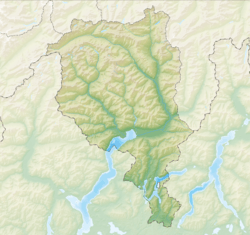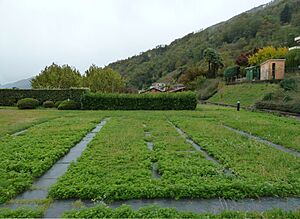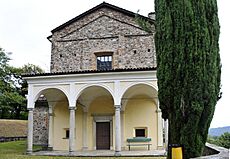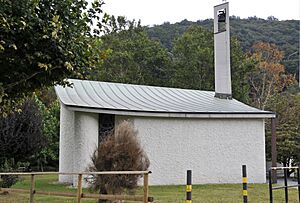Bioggio facts for kids
Quick facts for kids
Bioggio
|
||
|---|---|---|
 |
||
|
||
| Country | Switzerland | |
| Canton | Ticino | |
| District | Lugano | |
| Area | ||
| • Total | 6.41 km2 (2.47 sq mi) | |
| Elevation | 314 m (1,030 ft) | |
| Population
(Dec 2020 )
|
||
| • Total | 2,689 | |
| • Density | 419.5/km2 (1,086.5/sq mi) | |
| Postal code |
6934
|
|
| Surrounded by | Agno, Alto Malcantone, Aranno, Cademario, Iseo, Lugano, Manno, Muzzano, Vernate, Vezia | |
Bioggio is a town in the Ticino region of Switzerland. It's located in the Lugano area. Bioggio became a bigger town in 2004 when it joined with two other places: Bosco Luganese and Cimo. Later, in 2008, the town of Iseo also became part of Bioggio.
Contents
History of Bioggio
Bioggio was first mentioned in the year 1335. But its history goes back much further! People have found many things from the Roman times here. This shows that Bioggio was an important place long ago.
In 1962, a Roman farm house from the 3rd century was found. Later, in 1992, a market building with baths (public swimming and bathing places) was discovered. These finds tell us a lot about daily life in Roman Bioggio.
Ancient Buildings and Churches
Even older discoveries were made during work on the Chapel of S. Ilario. Inside, they found parts of a wooden religious building from the 8th century. This shows that people have been gathering for worship in Bioggio for a very long time.
During the Middle Ages, rich families from nearby areas owned a lot of land in Bioggio. The church also had many properties. In the 13th century, a monastery owned many rental homes and farms here. These properties were later given to another monastery in Lugano.
The church of S. Maurizio was first mentioned in 1261. But digging in 1997–98 showed its foundations are from the 5th–6th century. The church was rebuilt in a classicist style between 1773 and 1791. However, its tower is from the older church. The S. Ilario chapel was made bigger in 1680 and has looked the same ever since.
Bioggio's Location and Transport
Historically, Bioggio was on an important travel route. This route went from Ponte Tresa to the Monte Ceneri pass. Today, Bioggio is still a key transport hub. It has access to the highway. Part of the Lugano-Agno airport is also in the town. There's even a freight station for trains. Since 1912, a local railway line has served Bioggio. In the 1960s, a large industrial area was built in the valley. Bioggio is now part of a bigger urban area.
Geography of Bioggio
Bioggio covers an area of about 6.43 square kilometers (2.48 square miles). A good part of this land, about 20.7%, is used for farming. Forests cover about 12.4% of the area. Around 18.5% of the land has buildings or roads. A small amount, 0.8%, is rivers or lakes.
Land Use and Features
In the built-up areas, industrial buildings make up 3.9% of the total. Homes and other buildings are 5.4%. Roads and transport areas are 7.0%.
Most of the water in Bioggio comes from flowing rivers. The town is in the Lugano district, in the lower Vedeggio valley. It includes the main village of Bioggio and two smaller areas called Gaggio and Mulini. As mentioned, Cimo and Bosco Luganese joined Bioggio in 2004.
Bioggio's Coat of Arms
The current coat of arms for Bioggio was chosen in 2004. It replaced the old symbols of the three towns that merged. The new design combines parts from the older coats of arms. It features a sword, an ash tree, a wavy line, and a fleur-de-lis.
People of Bioggio
Bioggio has a population of about 2,600 people. As of 2008, about 17.9% of the people living here were from other countries. Over ten years, from 1997 to 2007, the population grew by about 13.5%.
Languages Spoken
Most people in Bioggio speak Italian, about 85.1%. German is the second most common language, spoken by 9.7% of the people. A smaller number, 1.6%, speak French.
Age Groups
Looking at the age groups in 2009:
- About 9.2% of the population are children aged 0 to 9 years old.
- Around 10.8% are teenagers aged 10 to 19.
- Adults aged 20 to 59 make up about 56.3% of the population.
- People aged 60 and older make up about 23.7% of the population.
Homes and Buildings
In 2000, there were 861 private homes in Bioggio. On average, about 2.4 people lived in each home. Most of the buildings were single-family homes, making up 63.7% of all inhabited buildings. There were also buildings with two families and some with many families. Some buildings were used for both living and business.
Important Heritage Sites
The Roman Cult Site and the Church of S. Maurizio are very important in Switzerland. They are listed as national heritage sites. The whole village of Iseo, which is now part of Bioggio, is also listed as a Swiss heritage site.
Economy and Jobs
As of 2007, the unemployment rate in Bioggio was 2.76%. This means most people who wanted jobs had them.
Types of Jobs
- A small number of people (23) work in the primary sector, which includes farming.
- Many people (1,482) work in the secondary sector. This involves making things in factories or construction.
- Even more people (1,340) work in the tertiary sector. This includes jobs like retail, services, and offices.
Many people travel into Bioggio for work. About 6.1 workers come into Bioggio for every one person who leaves to work elsewhere. About 24.8% of the workers coming in are from outside Switzerland. Most people use a private car to get to work, while some use public transport.
Bioggio is also home to the headquarters of Darwin Airline.
Religion in Bioggio
According to the 2000 census:
- Most people, about 80.8%, are Roman Catholic.
- About 7.9% belong to the Swiss Reformed Church.
- A smaller group, about 8.51%, belong to other churches.
- About 2.79% of the population did not state their religion.
Education in Bioggio
Switzerland has a good education system, and Bioggio is no different. About 77.6% of adults (aged 25 to 64) in Bioggio have finished high school or gone on to higher education.
School System
In 2009, there were 402 students in Bioggio.
- Kindergarten: Children can attend up to three years of non-mandatory kindergarten. In Bioggio, 72 children were in kindergarten.
- Primary School: This program lasts for five years. In Bioggio, 106 students attended standard primary schools.
- Lower Secondary School: After primary school, students can choose different paths. Some go to a two-year middle school, followed by a pre-apprenticeship. Others go to a four-year program to prepare for university.
- Upper Secondary School: This level prepares students for a trade or for university. Students can do vocational training while working or go to school full-time.
- Professional Program: This three-year program prepares students for jobs in fields like engineering, nursing, or business.
Many students from Bioggio attend schools outside the town. Also, students from other towns come to study in Bioggio.
Transport in Bioggio
Bioggio has two train stations: Bioggio station and Bioggio Molinazzo station. Both are on the Lugano–Ponte Tresa railway line, which connects to Lugano. Trains run regularly, every 15 minutes during weekdays and every half-hour at other times. Bioggio is also served by buses from Autopostale.
See also
In Spanish: Bioggio para niños












